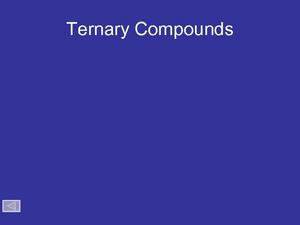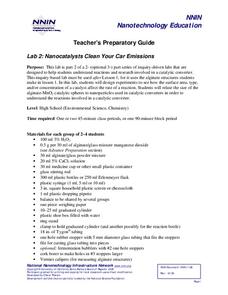Curated OER
Multi-Vitamins
Hear is a close-up inspection of some of the compounds found in the Centrum Multi-Vitamin. Each slide shows the steps required for forming one. The compounds are as follows: chromium (III) chloride, cupric sulfate, manganese (III)...
Curated OER
Lab: Percent of Composition of KClO3
Students find the percent of oxygen in potassium chlorate. In this percent composition lesson plan, students heat a solution of potassium chlorate using a catalyst, manganese dioxide, to decompose the potassium chlorate and release...
PBS
The Elements
An attractive handout displays the periodic table of elements in full color. Each group has its own color, and each element is represented by its name, chemical symbol, atomic number, and atomic weight. What makes this periodic table...
Curated OER
Catalysts and Enzymes
Biochemists experiment with the oxothermic decomposition of hydrogen dioxide by adding manganese dioxide. They observe how pepsin enhances the action of acid on the digestion of egg white proteins. They use yeast to make bread rise. All...
National Institute of Open Schooling
d-Block and f-Block Elements
Potassium permanganate, containing manganese one of the transition elements, has many uses such as mouthwash and propelling rockets, making it is a very diverse compound. The lesson delves into such transition elements and...
Curated OER
The Role of Enzymes
Learners explore the role of enzymes in chemical reactions. In this enzymes lesson plan, students use hydrogen peroxide and manganese dioxide to observe a chemical reaction. Learners observe the rates of reactions of chalk, hamburger,...
Curated OER
Elements of the Periodic Table
For this chemistry worksheet, students identify and locate various vocabulary terms relating to the elements found in the periodic table. There are 116 chemistry terms located in the word search.
Curated OER
Ternary Compounds
Practice naming ternary compounds with this PowerPoint presentation. Individual slides show the patterns for memorizing the nomenclature for polyatomic ions. Several examples are included for student practice. This thorough and...
Beyond Benign
Catalysts and Oxygen
Here is an engaging and hands-on lesson plan that allows high school chemists to demonstrate the effects of a catalyst on various chemicals. They garner knowledge of how reactants and products differ from one another, while...
National Institute of Open Schooling
Heavy Metal Contamination
An informative lesson focuses on heavy metal contamination of environments. Classes read about, discuss, and answer questions pertaining to sources of heavy metals in the environment. To finish the 35th installment of 36, individuals...
National Nanotechnology Infrastructure Network
Lab 2: Nanocatalysts Clean Your Car Emissions
Surface area certainly surfaces as a variable for chemical reaction rates. Scholars perform an experiment to discover how the size of catalysts affect the rate of a chemical reaction. They record their results in tables and graphs to...
Curated OER
Stoichiometry
In this stoichiometry worksheet, students use balanced equations for chemical reactions to determine the percent yield and the mass of product produced. This worksheet has five problems to solve.
Curated OER
Molarity of Solutions
In this molarity instructional activity, students determine the mass needed to make the given solutions and calculate molarity and volume of solutions. This instructional activity has 14 problems to solve.
Curated OER
Formulas
There are two sheets here, with 100 problems total. The first half is a list of compounds, and your young chemists should write the chemical formula for each. The next fifty give the formula and the name is required. You...
Science Teachers
Basic Periodic Table of the Elements
This basic, black-and-white printable is a copy of the periodic table of elements. It includes the standard element name, symbol, atomic number, and atomic weight. Across the bottom is an explanation that says for elements without stable...
Curated OER
Understanding Chemical Equations
In this chemical equations worksheet, students identify the reactants and the products, state what phase each is in, and state the mole ratios of all the products and reactants. Students complete 10 problems.
Creative Chemistry
Transition Metal Ions and Redox
In this transition metal ions and redox learning exercise, high schoolers read about the formation of metal ions through oxidation and reduction.
Curated OER
Water Pollution Lesson Plan: All Messed Up
Students map and calculate the area of the school parking lot and then the volume of water falling on the school parking lot. They map the route surface runoff will take to the nearest water body and describe the roles that human...
Curated OER
Transition Metals
Middle schoolers identify and describe transition metals. They discuss alloys and their benefits. Students research one common, alloy, its composition, properties, and uses. They are asked for some common properties of most transition...
Curated OER
Transition Metals (II)
Students discuss transition metals, their properties, and where they are located on the periodic table as well as why transition metals are ideal for coins. After discussion, they conduct an experiment using copper in the form of old...
Curated OER
Compound Names and Formulas
In this chemistry worksheet, learners identify 12 compounds based on their chemical formulas and write chemical formulas for 12 additional compounds.
Curated OER
Producing and Testing for Gases
In this gases worksheet, students conduct an experiment to produce 2 different gases and use standard tests to identify each gas. This worksheet has 14 short answer questions.
Curated OER
Chem 152-Electrochemistry
In this electrochemistry worksheet, students solve a variety of problems including identifying parts of oxidation and reduction reactions, writing balanced equations for galvanic cells, determining free energy and equilibrium constants...
Curated OER
The Chemistry of Art
In this chemistry of art worksheet, learners read about the chemical reactions that turn art made of different metals colors. They answer three questions about the chemical reactions related to metals and art.

























